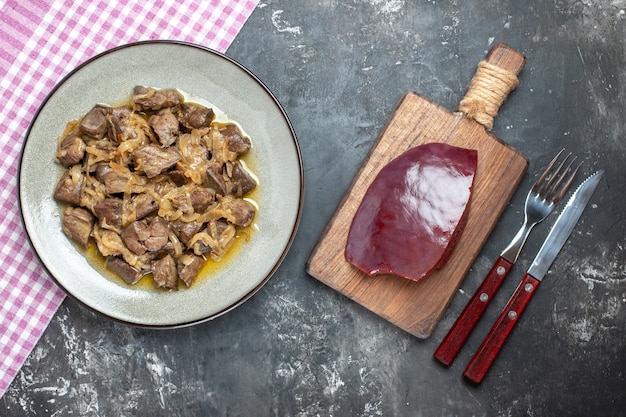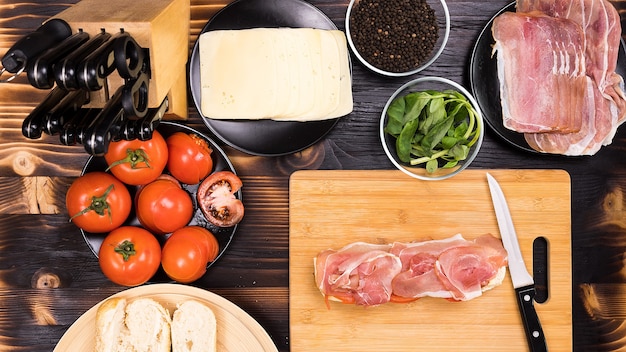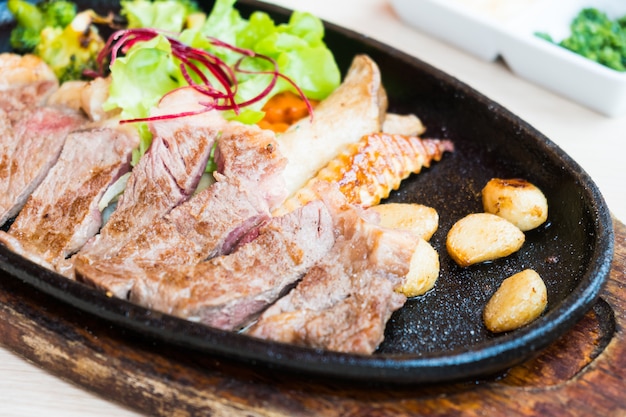Let's talk pork loin, shall we? It's a versatile cut of meat that can be cooked in so many ways – a delicious Sunday roast, a quick weeknight dinner, or even a show-stopping dish for a fancy dinner party. But I'll be honest, getting that perfect pork loin can be a bit of a challenge. You don't want it dry as a bone, but you also don't want it pink in the middle, do you? This guide is my own personal journey to pork loin perfection. I've tried all sorts of methods, made a few mistakes along the way, but ultimately learned how to consistently achieve juicy, flavorful results. So, buckle up, folks, because we're about to embark on a culinary adventure together.
(Part 1) Choosing the Right Pork Loin

The first step to a perfect pork loin is selecting the right cut. Now, I'm a big fan of bone-in pork loin. It tends to be more flavorful, and the bone acts as a natural heat conductor, ensuring even cooking. The bone also adds a lovely richness to the flavor. Plus, it looks impressive! But, hey, if you're short on time, or prefer a boneless option, go for it! Just make sure it's a good quality cut.
Knowing Your Pork Loin
Before you even think about grabbing a pork loin from the butcher, you need to know what you're looking for. A good pork loin should have a firm texture, a pale pink color, and a bit of marbling. Marbling is the streaks of fat throughout the meat, which adds flavor and juiciness. Avoid any loin that feels slimy or has a strong, unpleasant odor. That's a big no-no, my friend. Trust your senses, they'll tell you what's good!
The Size Matters
Think about how many people you're feeding. A smaller loin is perfect for a couple, while a larger one is ideal for a family gathering. Don't be afraid to ask your butcher for advice, they're the experts! They can help you choose the perfect size for your needs. And remember, a little extra is always better than not enough, so go for a slightly larger piece if you're not sure. There's nothing worse than running out of food when you've got hungry guests!
(Part 2) Preparing the Pork Loin

Right, you've got your pork loin, now what? Preparation is key, my friend. It's not just about slapping some seasoning on it and chucking it in the oven. There's a little more to it than that. But don't worry, it's not rocket science! Follow these simple steps and you'll be well on your way to pork loin perfection.
The Art of Patting
First things first, pat that pork loin dry with some kitchen paper. Why? Because a dry surface allows the seasoning to adhere better, creating a beautiful, flavorful crust. Believe me, a crispy crust on pork loin is a game changer. It's a texture thing, you see, a delicious crunch that adds another dimension to the dish.
Seasoning, the Star of the Show
Now, the fun part – seasoning! This is where you can get creative. I love a simple blend of salt, pepper, and garlic powder. It's classic for a reason. But if you're feeling adventurous, try adding some paprika, thyme, rosemary, or even a pinch of cayenne pepper. Don't be afraid to experiment, my friend. It's all about finding the flavours that suit your taste. You can also use pre-made seasoning blends, like a Cajun spice rub or a Mediterranean blend.
The Secret to a Juicy Loin
Here's a little secret: rubbing the pork loin with olive oil before seasoning helps to create a lovely, golden-brown crust while keeping the meat moist. It's like giving the pork loin a little hug before it goes into the oven. Just a light coating is all you need. Too much oil will make the loin greasy and it won't crisp up properly. Trust me on this one. You want that perfect balance of crispy skin and juicy meat.
(Part 3) Cooking Methods

Now, we're getting into the nitty-gritty, the heart of the matter. There are a few popular ways to cook a pork loin, and each one has its own advantages and disadvantages. Let's explore some of them.
oven roasting, a Classic Choice
This is my go-to method, the one I always fall back on. It's simple, reliable, and produces delicious results. Preheat your oven to 350°F (175°C). Place the seasoned pork loin in a roasting pan, and roast for about 45 minutes to an hour, or until the internal temperature reaches 145°F (63°C). A meat thermometer is your best friend here, folks. It takes the guesswork out of cooking and ensures you get a perfectly cooked pork loin every time. Don't rely on just looking at the colour, as that can be misleading. A thermometer is your trusty sidekick for achieving that perfect level of doneness.
The Grill, for a Smoky Flavour
If you're a fan of a smoky flavour, grilling is the way to go. Preheat your grill to medium heat, and cook the pork loin for about 20-25 minutes, turning occasionally, until the internal temperature reaches 145°F (63°C). Be sure to keep an eye on it, and rotate it if needed, to ensure even cooking. And remember, the grill can be unpredictable, so use a thermometer to avoid overcooking. For extra smokiness, try using wood chips soaked in water. Just place them in a foil packet on the grill, and they'll infuse the pork loin with a delicious smoky aroma.
The Magic of slow cooking
For the ultimate in tender and juicy pork loin, slow cooking is the answer. Place the seasoned loin in your slow cooker, and cook on low for 6-8 hours, or on high for 3-4 hours. The slow and gentle heat breaks down the tough connective tissues, making the pork incredibly tender and flavorful. You can also add some vegetables to the slow cooker, such as onions, carrots, or potatoes, for a complete meal. Talk about a stress-free dinner, eh? Just throw it in the slow cooker in the morning, and come home to a delicious, comforting meal. You can even make a simple gravy using the juices from the slow cooker.
(Part 4) Resting is Key
Now, you've cooked your pork loin perfectly, but the journey isn't over yet. Let that beauty rest for 10-15 minutes before carving. Why? Because resting allows the juices to redistribute throughout the meat, resulting in a moister and more flavorful pork loin. It's like a little breather for the meat, giving it a chance to settle down and release its deliciousness. Let it rest in a warm place, covered loosely with foil. This will keep it moist and prevent it from getting cold too quickly.
The Art of Carving
After resting, it's time to carve that beautiful pork loin. Use a sharp carving knife, and slice the loin into thick, even pieces. Don't be afraid to use a little force, but remember, we don't want to shred the meat. We want beautiful, impressive slices. If you're slicing for a roast dinner, consider slicing the loin into thick medallions. For sandwiches or salads, you can slice it thinner.
Serving Up the Goodness
Now, you've got your perfectly cooked and carved pork loin. The moment of truth is here. How you serve it is up to you, but here are a few ideas:
- roast pork Dinner: Serve the pork loin with roasted vegetables, Yorkshire pudding, and gravy. This is a classic combo for a reason. It's hearty, comforting, and always a crowd-pleaser. You can also add some apple sauce or cranberry sauce for a sweet and tangy counterpoint to the savoury pork.
- Pork Loin Sandwich: Slice the pork loin thinly, and pile it high on a crusty roll with your favorite toppings. Try adding some tangy slaw, creamy avocado, or spicy mustard. It's a delicious way to use leftover pork loin. For a more gourmet touch, use a brioche bun.
- Pork Loin Salad: Slice the pork loin thinly and toss it with a bed of mixed greens, roasted vegetables, and a light vinaigrette. This is a healthy and flavorful option, perfect for a summer lunch or dinner. You can also add some crumbled feta cheese or toasted pecans for extra flavor and texture.
(Part 5) Temperature Guide and Doneness
One of the most important aspects of cooking pork loin is getting the internal temperature right. We don't want it undercooked, and we don't want it overcooked. So, how do you know when it's done?
The Magic Number: 145°F (63°C)
The USDA recommends cooking pork loin to an internal temperature of 145°F (63°C). This ensures that any harmful bacteria are killed. Anything lower, and you're taking a risk. Anything higher, and you'll end up with dry, tough meat. So, invest in a meat thermometer. It's a small investment, but it will pay dividends in the long run. It's a must-have tool for any home cook.
Understanding Doneness
Here's a quick guide to help you determine the doneness of your pork loin:
| Doneness | Internal Temperature (°F) | Internal Temperature (°C) | Appearance |
|---|---|---|---|
| Rare | 125-130°F | 52-54°C | Very red and juicy |
| Medium-rare | 130-135°F | 54-57°C | Pink and juicy |
| Medium | 135-140°F | 57-60°C | Slightly pink and juicy |
| Medium-well | 140-145°F | 60-63°C | Pale pink and slightly firm |
| Well-done | 145°F and above | 63°C and above | White and firm |
Don't Be Afraid to Overcook
Now, if you're worried about overcooking the pork loin, don't be. It's better to err on the side of caution. A slightly overcooked pork loin is still edible, but an undercooked one is a health hazard. So, use that thermometer, and don't be afraid to take it out a few degrees early. It's better to be safe than sorry. You can always slice it open to check the doneness, too. Just be careful not to let the juices leak out!
(Part 6) Leftovers, Don't Waste Them
Leftover pork loin is a culinary treasure. Don't throw it away! It can be used in a variety of delicious dishes. Here are a few ideas:
The Ultimate Leftover pork loin recipe
One of my favorite ways to use leftover pork loin is in a delicious pasta dish. Simply dice the leftover loin, sauté it with some onions and garlic, and toss it with your favorite pasta, pesto, and a handful of grated Parmesan cheese. It's a quick, easy, and incredibly flavorful meal. You can also add some cherry tomatoes or spinach for extra flavour and nutrition.
Other Leftover Pork Loin Ideas
- Pork Loin Salad: Slice the leftover loin thinly, and toss it with a bed of mixed greens, roasted vegetables, and a light vinaigrette. This is a healthy and flavorful option, perfect for a summer lunch or dinner. You can also add some crumbled feta cheese or toasted pecans for extra flavor and texture. A drizzle of balsamic glaze adds a touch of sweetness and richness.
- Pork Loin Soup: Dice the leftover loin and add it to your favorite soup recipe. It adds a delicious depth of flavor and protein. Try it in a hearty lentil soup or a creamy tomato soup. You can also use it in a Vietnamese pho soup or a Thai curry.
- Pork Loin Hash: Dice the leftover loin and combine it with potatoes, onions, and peppers. Sauté the mixture in a pan until the potatoes are golden brown. This is a perfect breakfast or brunch option. You can also add some chopped chorizo or a dollop of sour cream for extra flavour.
(Part 7) Tips and Tricks
Now, let's talk about some tips and tricks to help you achieve pork loin perfection. These are my hard-earned secrets, my little nuggets of wisdom, if you will.
Don't Be Afraid to Experiment
Remember, cooking is an art, not a science. Don't be afraid to experiment with different seasonings, cooking methods, and serving ideas. You might just discover your new favorite pork loin recipe. Try using different herbs and spices, or even adding some citrus zest or a splash of honey for a unique flavour.
The Power of Brining
If you're looking to take your pork loin to the next level, try brining it. Brining involves soaking the pork loin in a salt water solution for several hours. This helps to retain moisture, resulting in a juicier and more flavorful pork loin. I personally find it to be a bit of a hassle, but if you're looking for the ultimate in moist and tender pork loin, it's worth a try. You can also add other flavourings to your brine, like sugar, herbs, or spices.
The Role of Fat
Don't be afraid of a little fat. A bit of fat on the pork loin helps to keep it moist and flavorful. If the loin is too lean, it can become dry and tough. So, don't trim all the fat, just a bit here and there. You can also score the fat with a sharp knife to help it render during cooking and create a lovely crispy crust.
The Importance of Resting
I've already mentioned the importance of resting, but it's worth repeating. Resting the pork loin allows the juices to redistribute, resulting in a moister and more flavorful dish. Don't skip this step. It's crucial! Resting also allows the meat to relax, making it easier to carve.
(Part 8) FAQs
Now, I know what you're thinking. You've got questions. And I've got answers.
1. Can I use frozen pork loin?
Yes, you can use frozen pork loin, but you'll need to thaw it completely before cooking. The best way to thaw frozen pork loin is in the refrigerator. It can take up to 24 hours to thaw a large pork loin, so plan ahead! Never thaw frozen pork loin at room temperature, as this can create a breeding ground for bacteria.
2. What are the different types of pork loin?
There are a few different types of pork loin, but the most common are center-cut loin and tenderloin. Center-cut loin is a thicker, more flavorful cut of meat, while tenderloin is a leaner, more tender cut. Both are delicious, so choose the one that best suits your needs. If you're looking for a leaner option, tenderloin is the way to go. But if you're craving that rich, succulent flavor, center-cut loin is the winner.
3. How long can I store leftover pork loin in the refrigerator?
Leftover pork loin can be stored in the refrigerator for up to 3-4 days. Store it in an airtight container or wrap it tightly in plastic wrap. You can also freeze leftover pork loin for up to 3 months. Be sure to label it with the date so you know when it was frozen.
4. What can I do if my pork loin is overcooked?
If you accidentally overcook your pork loin, don't despair! It's still edible, but it might be a bit dry. You can try to salvage it by shredding it and using it in a recipe that calls for cooked pork, such as tacos, pulled pork sandwiches, or a hearty soup. You can also add a little bit of broth or sauce to the shredded pork to make it more moist.
5. What are some other things I can cook with my pork loin?
Pork loin is a versatile cut of meat, and there are endless possibilities when it comes to cooking with it. Here are a few ideas:
- Pork Loin with Apples and Sage: This classic combination is delicious and easy to make. Simply roast the pork loin with apples and sage, and serve it with a side of mashed potatoes. You can also add some onions and carrots to the roasting pan for a complete meal.
- Pork Loin with Pineapple Salsa: This recipe is a taste of the tropics, and it's perfect for a summer barbecue. Simply grill the pork loin and serve it with a tangy pineapple salsa. For extra flavor, try grilling the pineapple slices alongside the pork loin.
- Pork Loin with Asian Glazed Vegetables: This recipe is a fusion of flavors, and it's sure to please everyone at the table. Simply roast the pork loin with glazed vegetables, such as carrots, broccoli, and bell peppers. Use a sweet and savory glaze made with soy sauce, honey, ginger, and garlic. The glaze will caramelize in the oven, creating a delicious, sticky coating.
There you have it, folks. My ultimate guide to perfectly cooked pork loin. It's a journey, a culinary adventure, and a delicious experience. So go forth, armed with this knowledge, and create your own pork loin masterpieces. And remember, don't be afraid to experiment. That's where the magic happens.
Everyone is watching

How to Cook Frozen Lobster Tails Perfectly: A Step-by-Step Guide
RecipesLobster. Just the word conjures up images of lavish meals, special occasions, and a taste of luxury. But let's...

Pigs in a Blanket Cooking Time: How Long to Bake for Perfect Results
RecipesAh, pigs in a blanket. Just the name conjures up images of those delightful little parcels of crispy pastry en...

Pork Fillet Cooking Time: How Long to Cook It Perfectly
RecipesPork fillet, or tenderloin as it's sometimes called, is a real favourite in our house. It's so versatile, and...

The Ultimate Guide to Cooking Delicious Frankfurters
RecipesLet's face it, we all love a good frankfurter. It's a classic, simple, and always satisfying. But let's be rea...

Wolf Meat Recipes: A Guide to Cooking Wild Game
RecipesLet's be honest, you don't see wolf meat at your local butcher shop every day. It's a bit of a wild card, but ...
